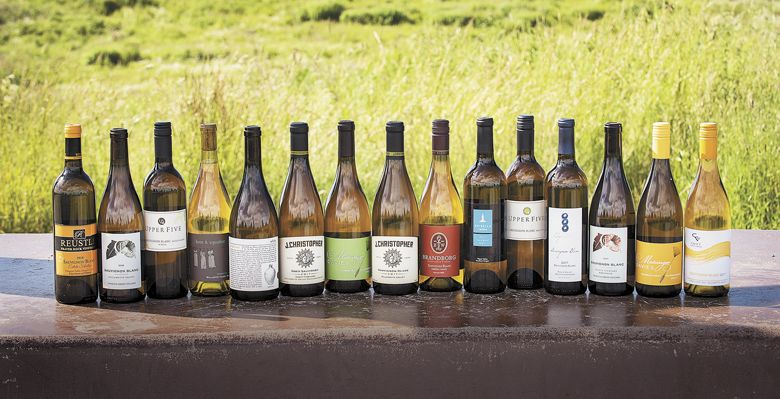Sauvignon Blanc Rising
Oregon winemakers give expressive white a proper boost
Sauvignon Blanc can be polarizing. Either you love it or hate it. And if you enjoy it, you likely feel passionately about one style over another — the tart and floral versions in France vs. the “grassy” glasses from New Zealand.
Although Oregon is probably not an obvious destination when seeking the white wine, you can find various local expressions, from the Willamette Valley to the Columbia Gorge to Southern Oregon. And as Sauvignon Blanc gains in popularity, the state’s selection also grows.
In 1961, Richard Sommer launched Oregon’s post-Prohibition era of winegrowing and planted Sauvignon Blanc — among other varieties, including the first Oregon Pinot Noir — at his HillCrest Vineyard in the Umpqua Valley. At one time, in the 1970s and ’80s, as the modern era of Oregon wine was continuing to take root, more Sauvignon Blanc, compared to Pinot Gris, was thriving in the state.
Jim Anderson of Patricia Green Cellars, with claims to of the oldest plantings of the variety in the Willamette Valley, recalls the early struggles of marketing the wine. “Sauvignon Blanc was difficult to sell world-wide — or at least domestically — and even places like Robert Mondavi changed the name of its Sauvignon Blanc to Fumé Blanc to create more marketability. If Mondavi was having problems with it, imagine early Oregon wineries trying to sell it.”
With lack of demand for the grape — and wine — plus the louse phylloxera wreaking havoc in vineyards, much of the Sauvignon Blanc was pulled out and replanted to another variety. By the late 1990s, hardly any was left in Oregon. And though only 88 acres are currently planted (according to the 2017 Oregon Vineyard and Winery Report by the Institute for Policy Research and Engagement at the University of Oregon), winegrowers are reinvigorating Sauvignon Blanc with new plantings every year.
Alongside other early Oregon growers, Chancy Croft of Croft Vineyards, who started planting Sauvignon Blanc in 1987, soon learned own-rooted vines are susceptible to phylloxera. Croft removed the infected vines in 2003. But, unlike others, he replanted Sauvignon Blanc vines with American rootstock. The Crofts currently farm more than 10 acres, and recently planted another half-acre of a new clone, with fruit expected from these vines this year. He says, “I don’t feel that there is a definitive Oregon Sauvignon Blanc style yet. Oregon winemakers are still discovering what this grape can do.”
Of course, it’s tempting to compare Oregon Sauvignon Blanc with the other famous regions, like Sancerre and New Zealand. Some say the local version tastes more akin to the Loire Valley, though wines like Andrews Rich’s Croft Vineyard Sauvignon Blanc do express the richness found in New Zealand styles. Matt Berson of Love & Squalor says, “It does its own thing in Oregon dirt. Mine, in particular, doesn’t have the greenness of the stereotypical New Zealand Sauvignon Blanc, nor the steely verve of my favorite French bottlings. The Love & Squalor is highly aromatic, pretty juicy and giving, and finishes with plenty of acid — as do most all of our wines.”
Winemakers/growers like Chris Berg, owner of Roots Wine Co., says, “In Oregon, we can have our cake and eat it, too. Meaning, that we can have wines either rich and textured or made like a quaffing white wine that is extremely food friendly.” He recently made a bubbly version — soon to be canned — and planted Sauvignon Blanc vines for a vineyard client near his Yamhill-Carlton AVA estate.
“Less cat pee; more sweet pea,” says Anna Matzinger, partner/winemaker of Matzinger Davies Wine Company. She says Oregon Sauvignon Blanc tends to show more lemon verbena, green melon, lime and always a vein of saline. “If one were to bookend Sauvignon Blanc in a broadly generalized way and say that some French (Loire) versions deftly incorporate texture and many New Zealand versions are known for vibrancy and intensity, we’d sit somewhere in between.”
Oregon Sauvignon Blanc is able to reach a level of ripeness that pushes it past some of the varietal characteristics people find off-putting — think sour, white grapefruit, herbaceous cut grass, and cat pee — and into more tropical characteristics while still retaining high levels of bright, citrusy acidity.
Matzinger, who sources her Sauvignon Blanc from the Columbia Gorge, appreciates freshness and vibrancy but also has an affinity for underlying texture, which she dreamily describes as “an expanse within the wine that can lend another dimension.” She strives to achieve this balance by picking on the early side and fermenting in a multitude of vessels: concrete egg, stainless steel tank, and cigar-shaped barrels — built by Philippe Grillot, the same cooper who fashioned these unique barrels for Didier Dagueneau in the Loire Valley.
Though challenges include heat and too much sunshine, many winemakers and growers agree that to retain distinctive fruit character and acidity, harvesting earlier is key; otherwise letting the fruit hang can produce wines with less vibrancy and interest. Although riper grapes can be a strategy for richer, more textured wines, some vintners say the fruit can lose expressiveness when picked later.
Anderson, who has produced most likely the largest single bottling of Oregon Sauvignon Blanc — 2,300 cases — states, “Sauvignon Blanc is pretty easy to grow here in the Willamette Valley, not unlike other varieties. It does require more leaf pulling, but it is also fairly hearty and not super-susceptible to rot/botrytis … Honestly, it’s way more comfortable growing here than Pinot Gris and produces more interesting, thought-provoking wines.”
“I’m glad Sauvignon is finally getting some recognition in the Willamette Valley,” says Andrew Rich, of Andrew Rich Wines. He’s been buying his fruit from Croft Vineyard in the Willamette Valley since the 1990s. Croft is a warmer site, and suited to Rich’s own style. After nearly 20 years of producing this wine, he says, “It always ripens, even in the cooler vintages, and it always maintains its acidity, even in the warmer years. I like to say it’s rich yet racy, year-in and year-out.”
Nora Lancaster, director of Kriselle Cellars in the Rogue Valley, adds, “I consider our Sauvignon Blanc a bridge between international styles: aspects of citrus and racy acidity like New Zealand, notes of grassy and elegance like Bordeaux, a little palate weight and ripe fruit like California. All of this comes from our distinctive wine crafting style.” Kriselle sources from three sites known to offer different expressions of the grape. They also pick at three varying levels of ripeness in order to create a dimension of flavors —less ripeness produces zesty citrus notes and bright acidity, while more ripeness provides touches of tropical and stone fruit characteristics.
Berson describes his first vintage of Sauvignon Blanc as horrible. As a less experienced winemaker — especially with this variety — Berson purchased a small amount of fruit that just never fully ripen but thought he could still turn it into decent wine. In the end, it became a good reminder of the importance of site and picking decisions. He believes Willamette Valley Sauvignon Blanc is a nice expression of the varietal if harvest is timed right and the winemaker doesn’t fuss with it too much.
People are quick to know the difference in Sauvignon Blanc around the world, but what about comparing Southern Oregon and the Willamette Valley? Terry Sullivan, winegrower/owner of Upper Five Vineyard, says, “As you know, there are, at least, two Oregons, and we are in the warm one. We love its expression here, where it gets away from the pungent New Zealand style — if you let it — and develops a multi-layered profile producing melon, stone fruit, honey and aromatics of honeysuckle. It still is true to Sauvignon Blanc with good acidity and, in some vintages, the minerality and grapefruit you expect from France.” A technique common among many producers of this variety, Upper Five’s winemaker John Grochau utilizes a variety of vessels for aging — stainless steel, acacia puncheons, neutral oak barrels — to coax out desired results: lean with mid-palate viscosity, roundness and fantastic floral elements.
Oregon Sauvignon Blanc continues to receive accolades and recognitions, including medals in the San Francisco Wine Competition, high scores in Wine Enthusiast, Wine Advocate, Wine Spectator and Great Northwest Wine, to name a few.
Sauvignon Blanc makes a wonderful complement to foods with a degree of spice, such as Thai or Indian curry. Also try it with prosciutto-wrapped feta-stuffed dates or more classic pairings like fresh oysters, crab and scallops.
Other notable producers worthy of mentioning: Quady North, Reustle-Prayer Rock, Craft Wines, Leah Jorgensen Wines, J. Christopher Wines, Ledger David Cellars, as well as Cellar Selects winners from the June 2019 edition of OWP: Puffin Brand, J. Scott Cellars, King Estate, Melrose Vineyards, Sweet Cheeks and La Randonnée.











